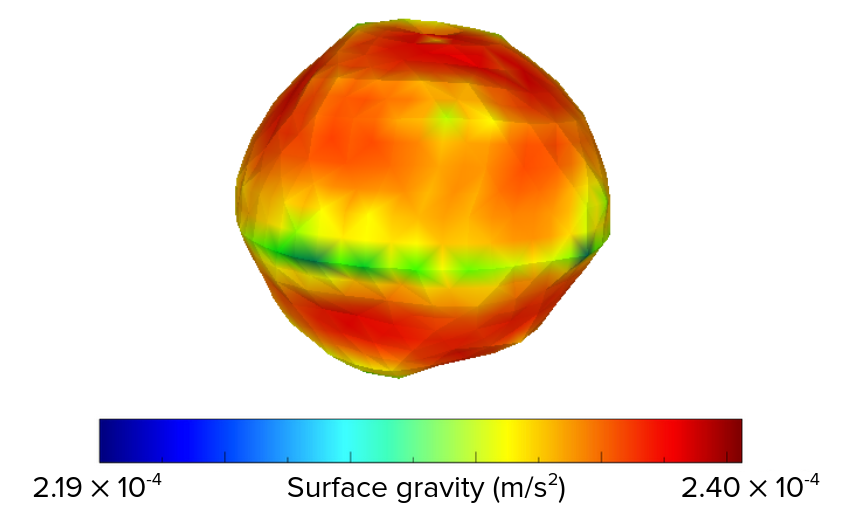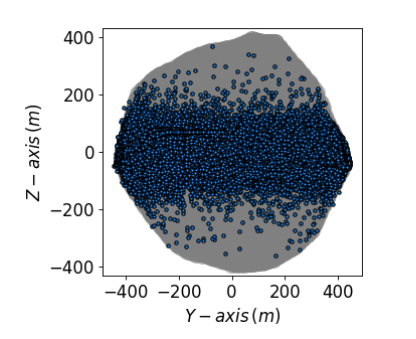Lifted particles from (65803) Didymos surface due to its fast rotation
- 1Instituto Universitario de Física Aplicada a las Ciencias y a las Tecnologías, Universidad de Alicante. Alicante, Spain (nair.trogolo@ua.es)
- 2Observtorio Astronómico de Córdoba, Universidad Nacional de Córdoba. Córdoba, Argentina.
- 3Departamento de Física, Ingeniería de Sistemas y Teoría de la Señal, Universidad de Alicante. Alicante, Spain.
- 4Instituto de Astrofísica de Andalucía, CSIC. Granada, Spain.
- 1Instituto Universitario de Física Aplicada a las Ciencias y a las Tecnologías, Universidad de Alicante. Alicante, Spain (nair.trogolo@ua.es)
- 2Observtorio Astronómico de Córdoba, Universidad Nacional de Córdoba. Córdoba, Argentina.
- 3Departamento de Física, Ingeniería de Sistemas y Teoría de la Señal, Universidad de Alicante. Alicante, Spain.
- 4Instituto de Astrofísica de Andalucía, CSIC. Granada, Spain.
1. Introduction
(65803) Didymos is a binary near-Earth asteroid (NEA) system and is the target of the upcoming DART (NASA) and Hera (ESA) space missions. Physical parameters of the system have been determined through radar and optical observations. A shape model for the primary, Didymos, is available, showing a top−shape appearance (see Fig. 1). Didymos is a 780 m asteroid with a satellite, Dimorphos, of 160 m in diameter [1]. Also, the main body is estimated to be an S-type asteroid with a density of 2170 ± 350 kg/m3 [2] and a fast rotation period of 2.2600 ± 0.001 h [3]. Given its spectral type, and considering that its meteorite analogs are ordinary chondrites, with a typical density greater than 3 000 kg/m3, Didymos is probably a gravitational aggregate (rubble-pile) [4]. In the equatorial region of such asteroids, the apparent non-inertial centrifugal force acting on surface particles can overcome the gravitational attraction of the asteroid, resulting in a local net outward acceleration, allowing them to leave the surface at zero speed and dynamically evolve in the system [5][6].
In this work we analyze conditions for regolith ejection and following dynamical evolution. In addition, we provide an estimation of the amount of material present in the system environment. The model predictions may be tested with data from the DART and Hera missions, making Didymos a particularly interesting system to study.

Figure 1: Surface gravity in the polyhedral shape model used for Didymos made by 1996 faces and 1000 vertices.
2. Methodology
In order to study the detachment process of particles on asteroid Didymos, we developed a numerical code that integrates the equation of motion of a test particle initially at rest at any position on the surface. We have taken into account the central gravitational field generated by the primary, both gravitational perturbation of the secondary and the Sun, and solar radiation pressure (SRP). Furthermore, since that is a rotating, non--inertial frame, it is necessary to consider the centripetal and coriolis forces. Initially, sample particles are located at the center of the triangular facets of the asteroid shape model, made by 1996 faces and 1,000 vertices. At each integration step, the detachment condition is studied (that is, the sum of the mentioned forces must be directed outwards). A 3D grid is set outside the asteroid in latitude, longitude and radial distance. Such a grid identifies 3D cells, where cumulative particle mass density is calculated. Based on particle trajectories, we defined four possible final states: ES1) particles that take off from the surface and land again, ES2) particles that remain in orbit, ES3) particles that are accreted into the secondary, and ES4) particles that escape from the system.
3. Numerical simulations and results
The sample particle differential size distribution follows a power law with a -3.5 slope and particles in the range [5 μm-2 mm] are considered. We analyzed the behaviour of particles during 30 days about perihelion and aphelion epoch and during a complete heliocentric orbit, equivalent to 2.11 Earth years. We find that orbiting particle mass density at the end of integration time (ES2) depends on the position of the asteroid in its orbit around the Sun, especially at small particle size. The system has a high eccentricity (e=0.38), leading to a 4/9 relationship between total mass around perihelion vs. aphelion (See Fig. 2). This is due to smaller particles being strongly influenced by the SRP during passage at perihelion. That circumstance leads them to either leave the system (ES4) or, after taking off, return quickly to the surface (ES1). In general, about 96% of particles that take off land back onto the surface of Didymos, sometimes even at relatively high latitudes (See Fig. 3). Those landing near the equatorial plane can be ejected again, triggering repeated regolith landing and taking off cycles.
| |
 |
| Fig. 2. Orbiting mass density versus radial distance after 30 days near perihelion and aphelion epoch. R = 0 m corresponds to the Didymos center, R ∼ 430 m to the surface. | Fig. 3. Projection of particle landing positions on the Didymos surface in the Z-Y plane. Each light blue dot corresponds to a particle, the size of the dot does not represent the real size. This is the simulation result over a complete orbit around the Sun (2.1 years). |
A crucial parameter in the problem we are analyzing is Didymos bulk density, which is currently known with a wide margin of uncertainty. We studied the relationship between the total mass in orbit after 30 days of evolution and the density of the asteroid, varying both the mass of Didymos and its volume. A lack of particles in the system environment is found only in 6% of simulation runs. This shows an optimistic scenario about observing particles in orbit around the asteroid, which perhaps can be estimated by measurement carried out by the Hera space mission.
References:
[1] Benner, L. A. et al. (2010) Bull. Am. Astron. Soc. 42, 1056.
[2] Fang J., Margot J.L., 2012, AJ, 143, 24
[3] Pravec P., et al., 2006, Icarus, 181, 63
[4] Campo Bagatin, A. et al. (2018) Icarus 302, 343–359.
[5] Campo Bagatin, A. (2013) LPSC.
[6] Yu, Y., et al. (2019) MNRAS 484, 1057–1071.
How to cite: Trógolo, N., Campo Bagatin, A., Moreno, F., and Pérez Molina, M.: Lifted particles from (65803) Didymos surface due to its fast rotation, Europlanet Science Congress 2022, Granada, Spain, 18–23 Sep 2022, EPSC2022-1044, https://doi.org/10.5194/epsc2022-1044, 2022.

